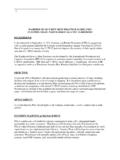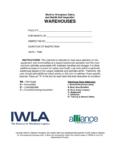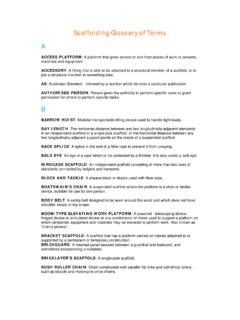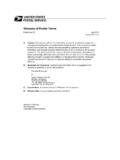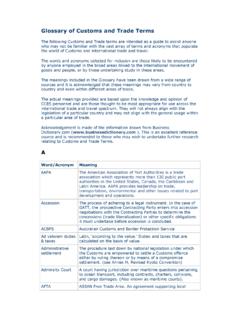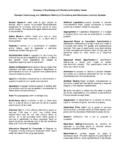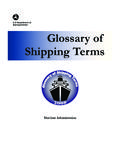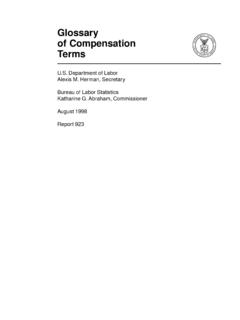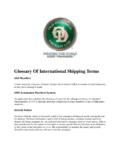Transcription of SUPPLY CHAIN and LOGISTICS TERMS and GLOSSARY …
1 S UPPLY CHAIN and LOGIS TICSTERMS and GLOSS ARYU pdatedFebruary, 2010 Please note: The International Warehouse LOGISTICS Association (IWLA) does not take responsibility for the content of these definitions and doesnot endorse these as compiled by: SUPPLY CHAIN , WashingtonPage1 of 136AA3 Method:The A3 system is a means of describing a business process in a compact form. It was originally created by the Toyota MotorCorporation and was named for the paper size on which it was printed: A3 (11 x 17 ). Toyota used the A3 methodology to help develop its famedToyota P roduction System (TP S).Abandonment:(1)The decision of a carrier to give up or to discontinue service over a route. Railroads must seek ICC permission to abandon routes.(2)As in the phrase "call abandonment". This refers to people who, beingplaced on hold in an incoming call, elect to hang up ("abandon") the centersmonitor closely the "abandonment rate" as a measure of their :See:Activity Based BudgetingABC:See:Activity Based CostingABC Classif ication:A method of classifying inventory items relative to their impact on total control.
2 ABC typically uses movement and cost data tocalculate the value of stock usage over the prior period, and uses the result as an element in ranking items under an 80/20 P areto rule for cyclecounting purposes. The group is divided intoclassescalled A, B, and C (and sometimes D) with The A group represents the highest value with 10 to20% by number of items. The B, C and D (if used) groups are each lower values but typically higher populations. Items with higher usage value are(the 20%) are counted more frequently. Specific bars to be used in setting ABC levels will vary by organization as they will impact the financialcontrol applied to inventory and the level of effort spent :Cycle CountingABC Costing:See:Activity Based CostingABC Frequency of Access:Location method where the determination of a product s location within the warehouse, or distribution center, is basedon 1)product s ABC Classification and 2) the number of times or rate of which the product is Inventory Control:A method of inventory control which divides items into categories based on value of usage, something like a P aretodivision where the items which constitute the highest dollar value are tracked more closely than those with lower value movement.
3 In this method anitem with high volumes of movement, but low cost, such as a small cheap fastener, would likely be counted less frequently than aslower moverwhich has a very high cost. Items are typically divided by a company defined set of values into A , B and C groups, and sometimes even a D group. The count frequencies arethenapplied to the groups. For example A class items may becounted weekly, B monthly, C quarterly, a part of a cycle counting Model:In cost management,a representation of resource costs during a time period that are consumed through activities and traced toproducts, services, and customers or to any other object that creates a demand for the activity to be System:In cost management, asystem that maintains financial and operating data on an organization s resources, activities, drivers, objectsand measures. ABC modelsare created and maintained within this M:See:Activity Based ManagementAbnormal Demand:Demand for a product which is either greater or lower than expected by a given percentage which is determined by theorganization.
4 When observed, it should be determined whether it may be a one-time spike, or if the effect is part of a trend which should beconsidered during future :See:Automated Broker InterfaceAB P:See:Activity Based PlanningAbsorption Costing:A cost accounting approach which captures overhead and other indirect costs as separate from unit costs for a given period,and then applies (absorbs) those costs into unit costs at the period end based on various factors such as movement and COGS UPPLY CHAIN and LOGIS TICSTERMS and GLOSS ARYU pdatedFebruary, 2010 Please note: The International Warehouse LOGISTICS Association (IWLA) does not take responsibility for the content of these definitions and doesnot endorse these as compiled by: SUPPLY CHAIN , WashingtonPage2 of 136 ACAT:See: Acquisition CategoriesAcceptable Q uality Level (AQ L):In quality assessment, acceptable quality level, also known as assured quality level, describes the maximumnumber of defects acceptable during the random sampling of an SamplingPlan:A quality management procedure which defines the sample sizes and acceptable defect levels for validating quality Number:See: Acceptable Quality LevelAcceptance Sampling:A statistical quality control method which tests samples of products at defined points as opposed to testing each :The ability of a carrier to provide service between an origin and a :A feature which can optionally be added to a finished good at the discretion of the customer.
5 An example would be the addition of aspecial trim feature to an :A carrier s charge for accessorial services such as loading, unloading, pickup, and Fee:See:Accessorial chargesAccountability:The act of making a group or individual responsible for certain activities or outcomes. For example, managers and executives areaccountable for business performance even though they may not actually perform the (A/P):1) a financial term referring to the amount of transactions which havebeen accrued but not paid to a vendor. 2) Anaccounting functionAccounts receivable (A/R):On a company's balance sheet, accounts receivable is the amount that customers owe to that company. Sometimes calledtrade receivables, they are classified as current assets assuming that they are due within one :The process in which certification of competency, authority, or credibility is presented. An example of accreditation is theaccreditation of testing laboratories and certification specialists that are permitted to issue official certificates of compliance with Standards Committee (ASC):A committee oftheANSI chartered in 1979 to develop uniform standards for the electronic interchangeof business documents.
6 The committee develops and maintains generic standards (X12) for Electronic Data bin:An area where item to be used inassembly of a product are staged prior to work being done. See: StagingAccuracy:A value, usually expressed as a percentage, which expresses the level of precision incurred during transactions. An example would beseen when comparing actual inventory levels to what was expected from bookkeeping :See:Automated Call DistributionACE:See:Automated Commercial EnvironmentACH:See:Automated ClearinghouseAcknowledgment:Typically this is a response, either electronic or as a physical document, which confirms the receipt of an order from the supplierto the Categories (ACAT) DoDACAT 1 programs are Milestone Decision Authority P rograms or programs designated ACAT 1 by theMilestone Decision UPPLY CHAIN and LOGIS TICSTERMS and GLOSS ARYU pdatedFebruary, 2010 Please note: The International Warehouse LOGISTICS Association (IWLA) does not take responsibility for the content of these definitions and doesnot endorse these as compiled by: SUPPLY CHAIN , WashingtonPage3 of 136 AcquisitionCost:The net price plus other costs needed to purchase the item and get it to the point of use.
7 These other costs can include: theitem'spurchasing costs (closing, research, accounting, commissions, legal fees), transportation, preparation and installation costsACSI:See:American Customer Satisfaction IndexAction Message:A system message usually created during MRP calculations to call attention to a current or potential problem and suggestcorrective :A specific method or process to achieve the results called for by one or more objectives. An action plan may be a simpler version of aproject Report:See: Action MessageActivation:TOC recognizes that it is possible to produce without contributing to defines production that contributes to throughputas utilization. P roduction that does not contribute to throughput is known as activation. Activation is not desired because it not only fails to increasethroughput, but it also increases inventory andoperating expense. This is consistent with the Just-In -Time (JI T) Inventory:Materials held in a facility, which are intended to be consumed in manufacturing / assembly, or sold in a specified periodActiveStock:Goods in active pick locations and ready for order :Work performed by people, equipment, technologies or facilities.
8 Activities are usually described by the action-verb-adjective-noun grammar convention. Activities may occur in a linked sequence and activity-to -activity assignments may Analysis:The process of identifying and cataloging activities for detailed understanding and documentation of their characteristics. Anactivity analysis is accomplished by means of interviews, group sessions, questionnaires, observations, and reviews of physical records of Based B udgeting (ABB ):An approach to budgeting where a company usesan understanding of its activities and driver relationships toquantitatively estimate workload and resource requirements as part of an ongoing business plan. Budgets show the types, number of and cost ofresources that activities are expected to consumebased on forecasted workloads. The budget is part of an organization s activity-based planningprocess and can be used in evaluating its success in setting and pursuing strategic B ased Costing (ABC):A methodology that measures the cost and performance of cost objects, activities and resources.
9 Cost objectsconsume activities and activities consume resources. Resource costs are assigned to activities based on their use of those resources, and activity costsare reassigned to cost objects (outputs) based on the cost objects proportional use of those activities. Activity-based costing incorporates causalrelationships between cost objects and activities and between activities and ased Management (AB M):A discipline focusing on the management of activities within business processes as the route to continuouslyimprove both the value received by customers and the profit earned in providing that value. ABM uses activity-based cost information andperformance measurements toinfluence management :Activity-Based CostingActivity B ased Planning (AB P):Activity-based planning (ABP ) is an ongoing process to determine activity and resource requirements (bothfinancial and operational) based on the ongoing demand of products or services by specific customer needs.
10 Resource requirements are compared toresources available and capacity issues are identified and managed. Activity-based budgeting (ABB) is based on the outputs of Dictionary:A listing and description of activities that provides a common/standard definition of activities across the organization. Anactivity dictionary can include information about an activity and/or its relationships, such as activity description, business process, function source,whether value-added, inputs, outputs, supplier, customer, output measures, cost drivers, attributes, tasks, and other information as desired to describethe Driver:The best single quantitative measure of the frequency and intensity of the demands placed on an activity by cost objects or otheractivities. It is used to assign activity costs to cost objects or to other Level:A description of types of activities dependent on the functional area.
